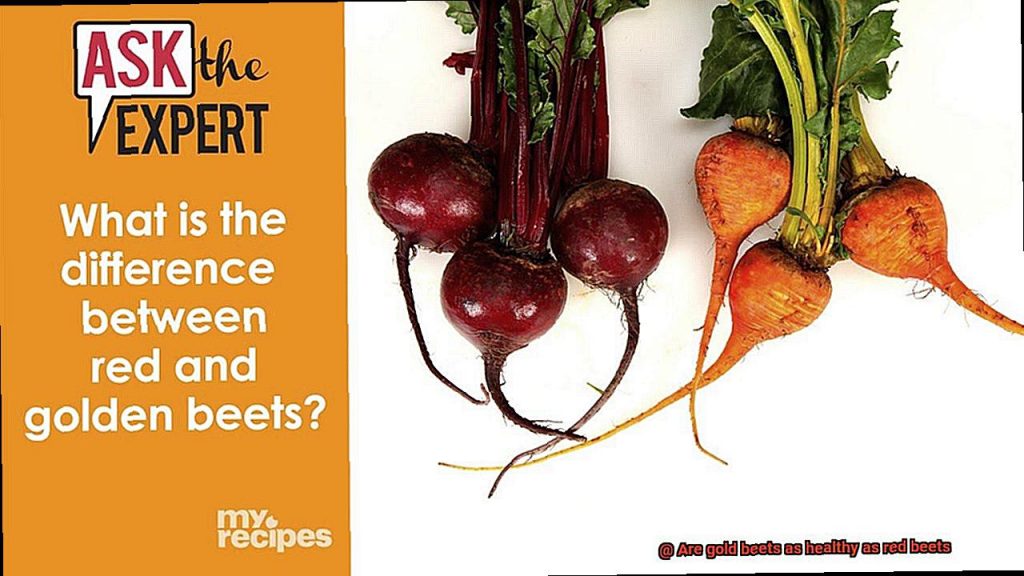Fresh beets are a treat for the senses – their vibrant colors and earthy flavors make them a staple in many dishes. If you’re used to the classic deep red beet, you might be surprised to learn that there’s a new kid on the block: gold beets. These colorful root vegetables offer a similar taste and texture to red beets, but are they just as healthy?
That’s the question on everyone’s mind – health enthusiasts and foodies alike. Both red and gold beets pack a punch of nutrients like fiber, vitamin C, and potassium. But could one variety have an edge over the other? In this blog post, we’ll take a closer look at the potential health benefits of both red and gold beets.
To understand why these root vegetables are considered superfoods, it’s important to know their history. Beets have been used for centuries in traditional medicine to treat ailments such as liver disease and constipation. Today, research suggests that they offer numerous health benefits including lower blood pressure, improved exercise performance, and even cancer prevention.
But where do gold beets fit into all of this? Are they just as nutritious as their crimson counterparts? We’ll explore that question in depth in this post. So sit back, relax, and let’s find out if gold beets can hold their own against the reigning champion – red beets.
Contents
Nutritional Benefits of Red Beets
Red beets are a true nutritional powerhouse, offering a wide range of health benefits that make them an excellent addition to any healthy diet. These vibrant vegetables are packed with essential vitamins and minerals, including vitamin C, folate, potassium, and manganese, which are crucial for maintaining good health and boosting the immune system.
In addition to their impressive nutrient profile, red beets are also an excellent source of dietary fiber. This fiber helps to improve digestion and prevent constipation while also lowering cholesterol levels and reducing the risk of heart disease. Eating red beets can help you feel full for longer periods, making it easier to maintain a healthy weight.
The high content of nitrates found in red beets is one of their most significant health benefits. When ingested, nitrates convert into nitric oxide in the body, which helps to dilate blood vessels and improve blood flow. This can lower blood pressure and reduce the risk of cardiovascular disease.
Red beets are also rich in antioxidants like betacyanin, which gives them their beautiful red color. Antioxidants protect cells from damage caused by free radicals, which can lead to chronic diseases such as cancer, Alzheimer’s, and Parkinson’s.
When it comes to choosing between gold beets and red beets for health benefits, red beets are the clear winner. While gold beets may have some nutritional value, they do not compare to the concentration of nutrients found in red beets.
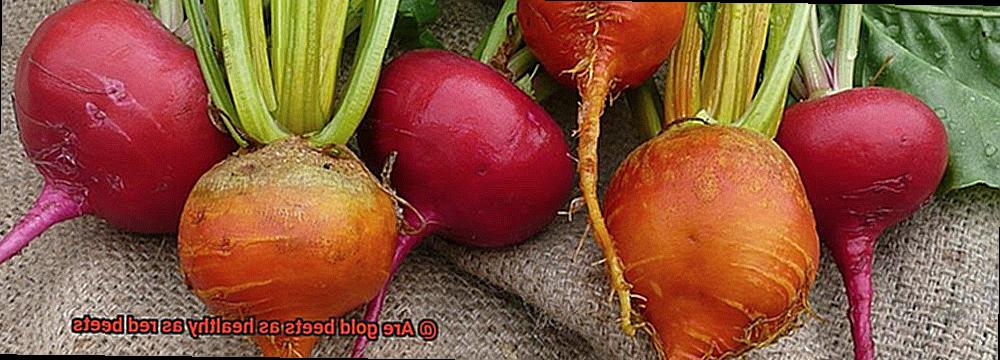
Nutritional Benefits of Gold Beets
If you’re looking for a delicious and nutritious addition to your diet, look no further than gold beets. These yellow or golden-hued root vegetables may not be as well-known as their red counterparts, but they offer just as many health benefits.
First and foremost, gold beets are an excellent source of fiber. This nutrient is essential for maintaining good digestive health and promoting regular bowel movements. By adding gold beets to your meals, you can help keep your gut happy and healthy.
But that’s not all – gold beets are also packed with antioxidants. These powerful compounds help protect your cells from damage caused by free radicals, which can contribute to chronic diseases like cancer and heart disease. By consuming more antioxidant-rich foods like gold beets, you’re giving your body an extra layer of protection against these harmful toxins.
In addition to fiber and antioxidants, gold beets are also a fantastic source of folate. This B-vitamin is crucial for cell growth and development, making it particularly important for pregnant women. Folate helps prevent birth defects in the baby’s brain and spine, so it’s essential for expectant mothers to get enough of this nutrient in their diets.
Finally, gold beets are high in potassium, a mineral that plays a vital role in maintaining healthy blood pressure levels. By consuming more potassium-rich foods like gold beets, you can help lower your risk of developing hypertension and other cardiovascular diseases.
Differences between Red and Gold Beets
You may already be familiar with the classic red variety. But have you tried the lesser-known gold beet? In recent years, this type of beet has been gaining popularity – and for good reason. While both red and gold beets are nutritious and delicious, there are some key differences between them that may influence your choice.
Color
The most striking difference between red and gold beets is their color. Red beets have a deep, vibrant color that comes from a pigment called betacyanin. In contrast, gold beets have a light yellow or gold color due to a different pigment called betaxanthin. Although this may not seem significant, research suggests that different colored fruits and vegetables contain varying types of beneficial phytonutrients. So why not switch it up and add some golden hues to your plate?
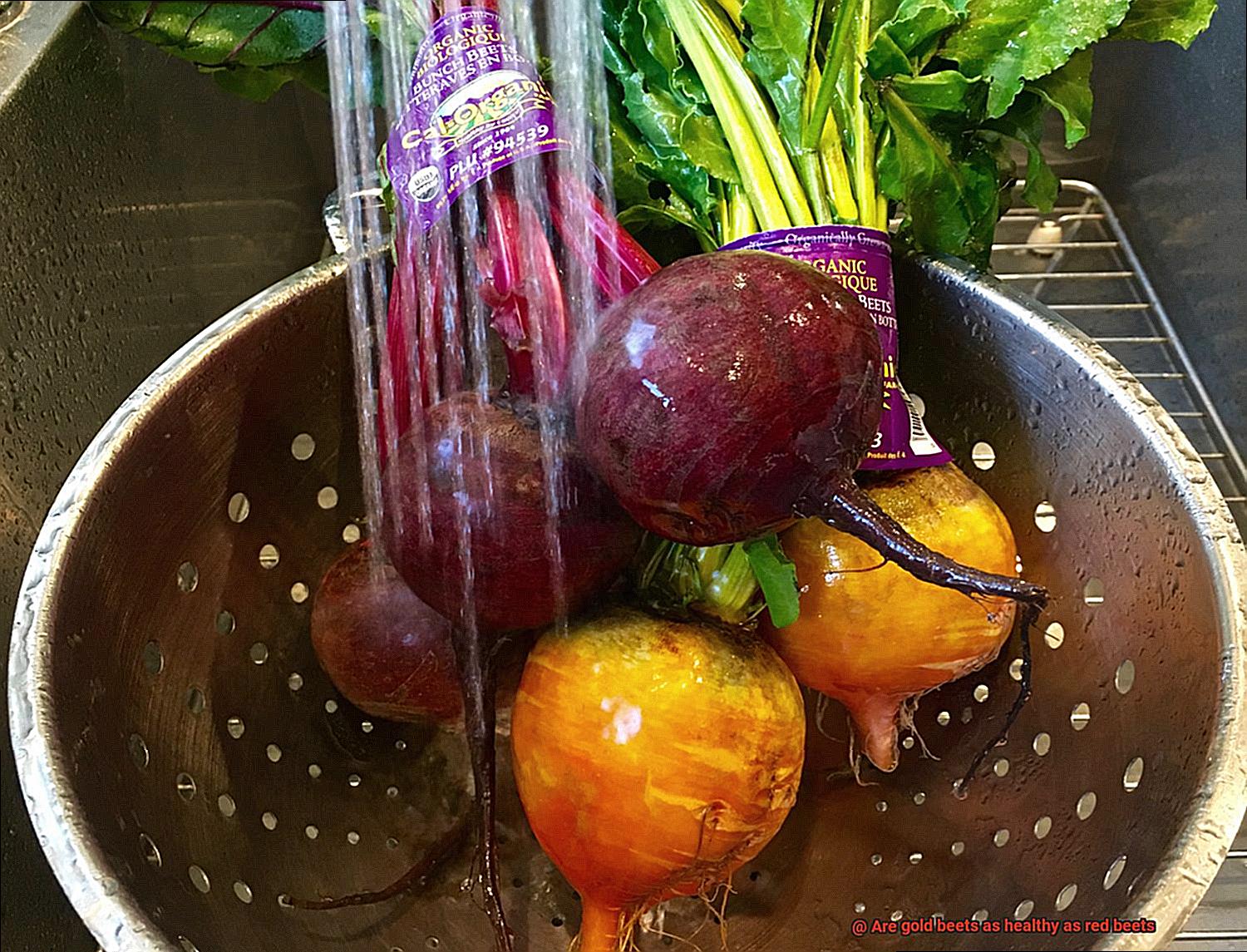
Flavor
Red beets are known for their earthy, slightly sweet flavor, which some people may find too strong for their liking. On the other hand, gold beets are milder and slightly sweeter than their red counterparts. This makes them a great option if you’re looking to incorporate beets into your diet but want a more subtle taste. Plus, the sweetness of gold beets can complement a variety of dishes, from salads to roasted vegetables.
Nutrition
Both red and gold beets are packed with essential vitamins and minerals. They’re both a great source of fiber, folate, potassium, and vitamin C – all of which are important for maintaining good health. However, red beets contain more betacyanin than gold beets, which studies suggest may have antioxidant and anti-inflammatory properties. So if you’re particularly interested in these benefits, red beets may be the way to go.
Antioxidant Levels in Red and Gold Beets
Antioxidants are crucial nutrients that protect our bodies from harmful free radicals that can wreak havoc on our cells and contribute to chronic diseases like cancer and Alzheimer’s. Luckily, both red and gold beets are rich in antioxidants, but the levels may vary.
Research has shown that red beets contain higher levels of antioxidants than gold beets. In fact, one study found that red beets had significantly higher levels of total phenolic compounds, anthocyanins, and vitamin C than gold beets. Another study discovered that the red pigment in red beets, betacyanin, had stronger antioxidant activity than the yellow pigment in gold beets, betaxanthin.
But don’t count gold beets out just yet. They still contain a significant amount of antioxidants, including betaxanthin and other phenolic compounds. Plus, they’re a great source of folate, potassium, and fiber.
It’s not just the color that matters – cooking method can also affect antioxidant levels in beets. Boiling or overcooking beets can cause some nutrients to break down or leach out into the cooking water. To preserve their antioxidant content, try roasting or steaming beets instead.
Other Beneficial Compounds in Red and Gold Beets
Red and gold beets are not only visually stunning but also incredibly nutritious. These vegetables contain a plethora of beneficial compounds that offer a range of health benefits, making them a must-have in any healthy diet.
Both red and gold beets are known for their high fiber content, which can aid in digestion and promote satiety. They are also rich in vitamin C, potassium, and folate, which support a strong immune system, reduce inflammation, and maintain healthy blood pressure levels.
However, what sets these two beet varieties apart are their unique compounds. Red beets are particularly rich in nitrates, which convert to nitric oxide in the body. This conversion helps to widen blood vessels and improve blood flow and oxygenation to organs and muscles. This effect has been shown to improve exercise performance and reduce the risk of cardiovascular disease.
On the other hand, gold beets contain higher levels of lutein and zeaxanthin, powerful antioxidants that protect the eyes from damage caused by free radicals and UV rays. Additionally, gold beets have a slightly sweeter taste than red beets due to their higher sugar content.
It is important to note that both red and gold beets contain betalain, a pigment that gives them their vibrant color but also has anti-inflammatory and anti-cancer properties.
Incorporating these root vegetables into your diet is easy and delicious. Try roasting them with a bit of olive oil and garlic, blending them into a smoothie or juice, or shredding them raw into a salad. The possibilities are endless.
Health Benefits of Eating Red or Gold Beets
If you’re looking for a simple and delicious way to boost your overall health, look no further than red or gold beets. These colorful root vegetables are packed with nutrients that can offer many benefits for your wellbeing.
First up, let’s talk about the benefits of red beets. These vibrant veggies contain betacyanin, a powerful pigment that has been shown to have anti-inflammatory and anti-cancer properties. Betacyanin also helps to support liver function and detoxification, making it an excellent choice for anyone looking to give their liver a little extra love. Plus, red beets are high in folate, which is crucial for healthy fetal development during pregnancy.
But don’t count gold beets out just yet – they’re packed with health-boosting nutrients too. While they may not be as strikingly colored as their red counterparts, they contain betaxanthins, which are responsible for their sunny yellow hue. These compounds have antioxidant properties and may help reduce inflammation in the body. And let’s not forget about fiber – gold beets are high in it, which supports digestive health and helps you feel full and satisfied.
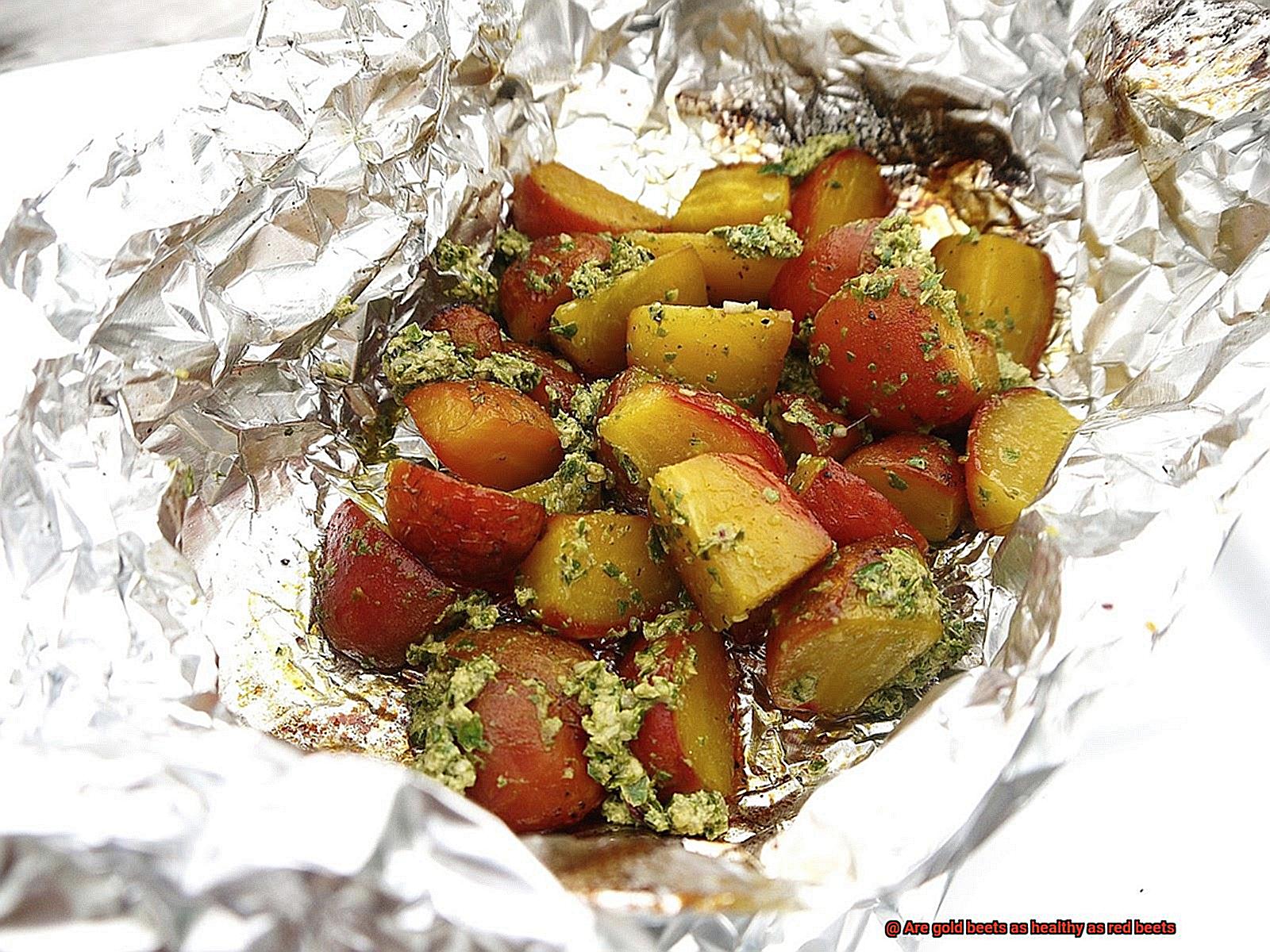
In addition to their unique nutritional content, both red and gold beets are also rich in vitamins and minerals that support overall health. Here are just a few examples:
- Potassium: Beets are an excellent source of potassium, which is important for maintaining healthy blood pressure levels.
- Vitamin C: Both red and gold beets contain vitamin C, which supports immune function and helps your body absorb iron.
- Iron: Speaking of iron, beets are a good source of this mineral, which is essential for healthy blood cells.
So whether you prefer the bold color of red beets or the sunny look of gold beets, incorporating either one into your diet can do wonders for your health. From reducing inflammation to promoting healthy digestion and even protecting against cancer, these nutrient-dense vegetables are a must-have in any healthy eating plan.
How to Prepare and Cook Red or Gold Beets
Beets are not only visually striking but also incredibly nutritious. Preparing and cooking them may seem like a daunting task, but it’s a straightforward process. In this article, we’ll cover five sub-sections to help you prepare and cook red or gold beets with ease.
Cleaning the Beets
Before cooking, it’s essential to wash the beets thoroughly to remove any dirt or debris. Then, trim off the tops and bottoms of the beets, and use a vegetable peeler to remove the skin. If the beets are small and tender, you can leave the skins on.
Roasting the Beets
Roasting beets is a popular method that creates a caramelized flavor and tender texture. Cut the beets into small, uniform pieces and toss them in olive oil, salt, and pepper. Spread them out in a single layer on a baking sheet and roast them in a preheated oven at 400°F for about 30-40 minutes until tender.
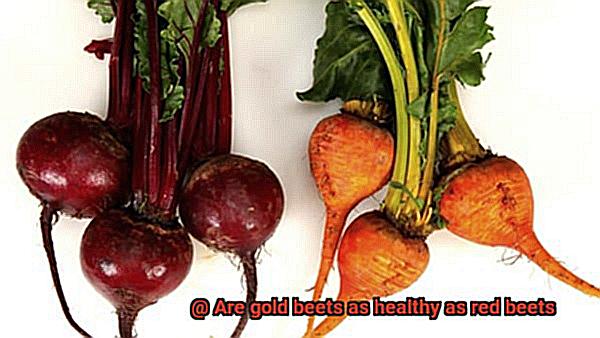
Boiling the Beets
Boiling is another option for cooking beets. Place peeled and chopped beets in a pot of boiling water and simmer them until they are tender, about 20-30 minutes. Drain the water and season the beets with salt and pepper.
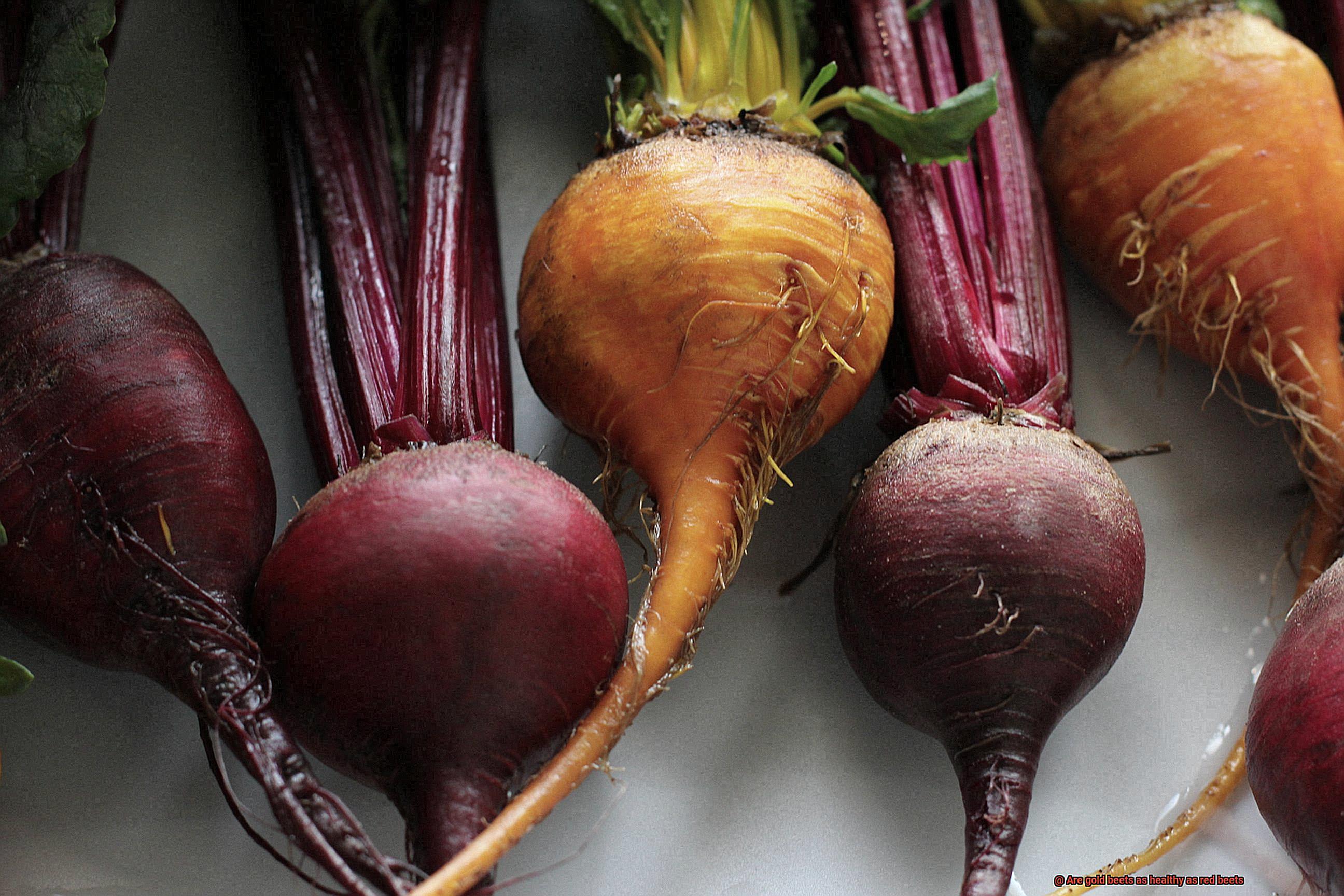
Grilling the Beets
Grilling is an excellent way to add a smoky flavor to your beets. Cut peeled and sliced beets into thin rounds or wedges and toss them in olive oil, salt, and pepper. Grill them over medium-high heat until they are tender and slightly charred, about 5-7 minutes per side.
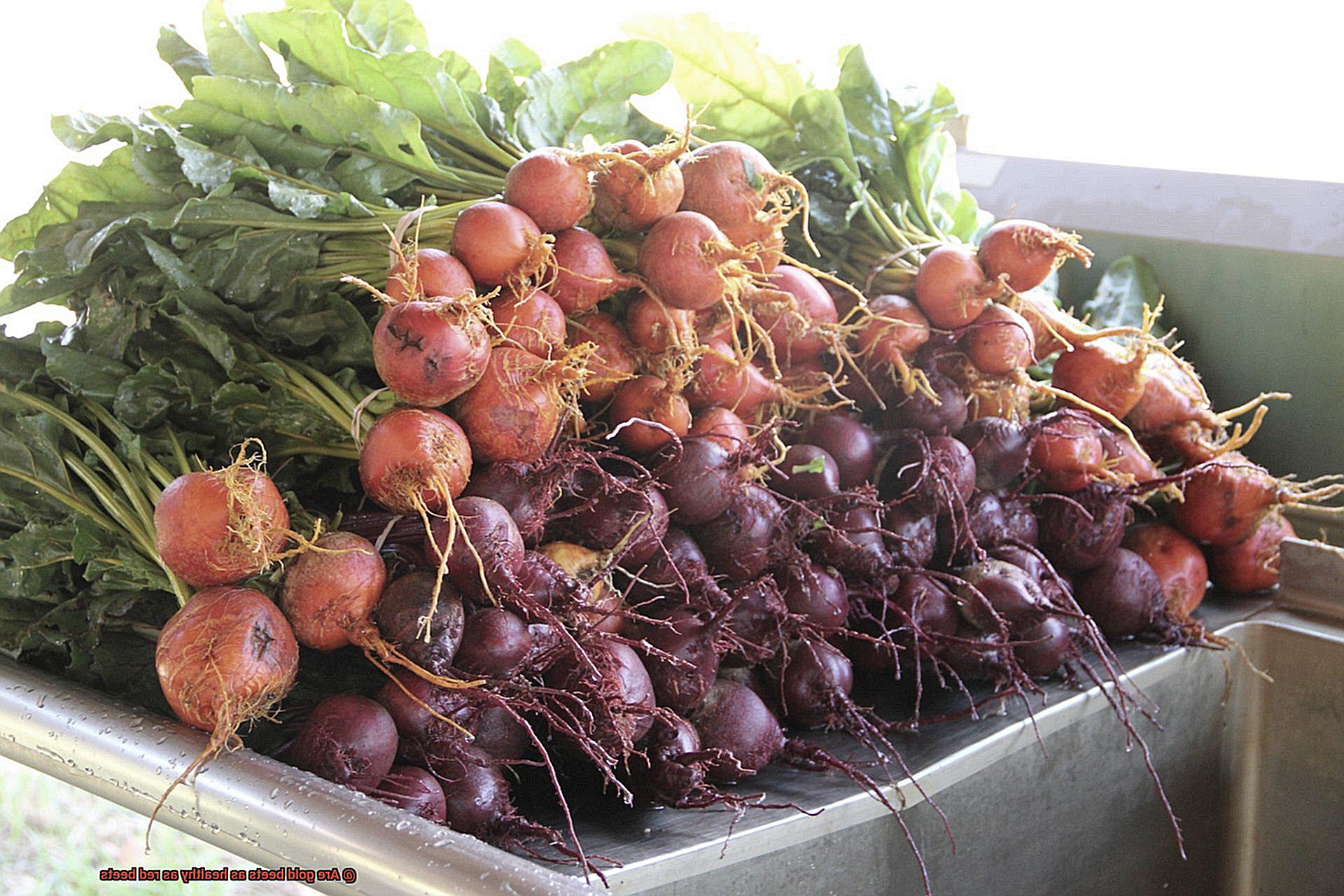
Peeling and Slicing the Beets
Once your beets are cooked and tender, let them cool before peeling off the skin with your hands or a vegetable peeler. Then, slice or dice them as desired for salads, side dishes, or other recipes.
Tips for Incorporating Red or Gold Beets into Your Diet
Red and gold beets are the perfect solution. These vegetables are packed with essential vitamins, minerals, and antioxidants that promote good health and prevent diseases. Plus, they’re incredibly versatile and can be easily incorporated into your diet in various ways.
Roasting
If you’re new to beets, roasting is the perfect starting point. Roasting brings out their natural sweetness and enhances their flavor. Simply wash and trim the beets, wrap them in foil, and roast them in the oven until they’re tender. Once they’re cooked, you can slice or dice them and add them to your salads or use them as a side dish.
Juicing
Beets are a popular ingredient in many juicing recipes as they’re rich in nutrients and provide a natural source of energy. You can juice red or gold beets with other fruits and vegetables for a delicious and healthy drink.
Grating
Grating raw beets is an easy way to add them to your meals without altering their flavor. You can grate them into your salads, sandwiches, or soups for an extra boost of nutrition.
Pickling
Pickled beets are a great snack or side dish that can be enjoyed on their own or added to sandwiches or salads. You can make your own pickled beets by boiling them in vinegar, sugar, and spices until they’re tender.
Spiralizing
Spiralizing is a fun way to add more vegetables to your meals. You can spiralize red or gold beets into long noodles and use them as a substitute for pasta in your favorite dishes.
Both red and gold beets offer numerous health benefits as they contain essential vitamins, minerals, and antioxidants that promote good health. While gold beets may have slightly higher levels of certain antioxidants than red beets, both varieties are equally nutritious.
JBQNNLH2xVI” >
Conclusion
In conclusion, it’s clear that both red and gold beets are nutritional powerhouses that offer a host of health benefits. While red beets boast higher levels of betacyanin and antioxidants like anthocyanins and vitamin C, gold beets are rich in betaxanthin, folate, lutein, zeaxanthin, fiber, and potassium.
To incorporate these vibrant veggies into your meals, there are endless possibilities. Roast them for a caramelized sweetness or boil them for a tender texture. Grilling or pickling adds a smoky or tangy twist to their earthy flavor. You can even grate them into salads or sandwiches for an added crunch or spiralize them into noodles as a healthy pasta alternative.
Whether you’re drawn to the bold hue of red beets or the sunny disposition of gold beets, incorporating either variety into your diet is a smart choice for your health. These root vegetables have been shown to reduce inflammation, promote healthy digestion, and protect against cancer.

